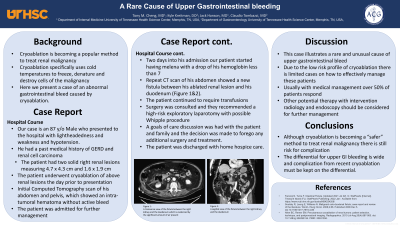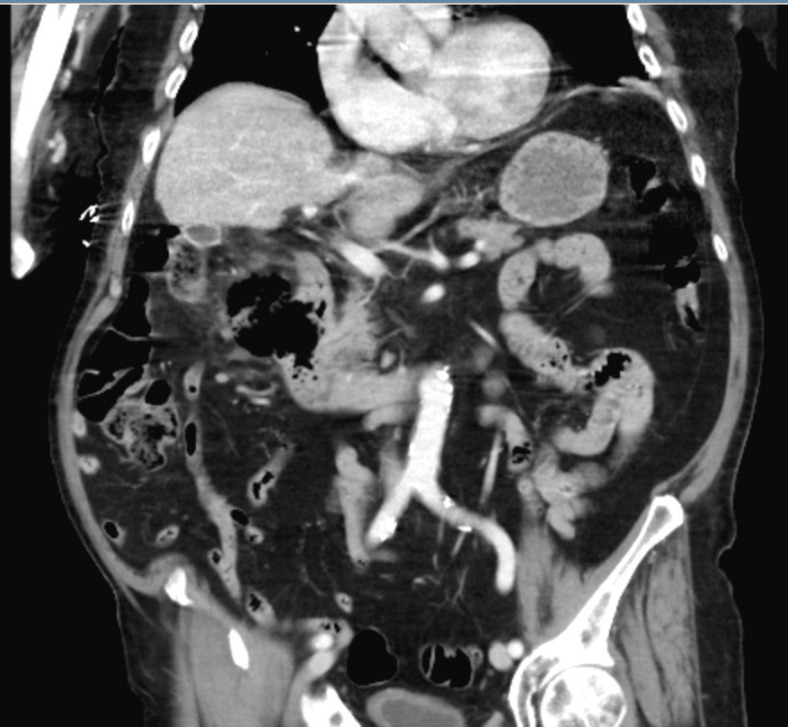Back


Poster Session B - Monday Morning
Category: GI Bleeding
B0349 - A Rare Cause of Gastrointestinal Bleeding
Monday, October 24, 2022
10:00 AM – 12:00 PM ET
Location: Crown Ballroom

Has Audio

Tony M. Cheng, MD
University of Tennessee Health Science Center
Memphis, TN
Presenting Author(s)
Tony M. Cheng, MD, Kyle Kreitman, MD, John Hanson, MD, Claudio Tombazzi, MD
University of Tennessee Health Science Center, Memphis, TN
Introduction: Cryoablation is becoming a popular way to treat renal malignancy due to its low incidence of serious complications, low morbidity and mortality, lower cost, and ease of outpatient therapy. The technique uses cold temperatures to freeze, denature, and destroy cells in the tumor. This technique is usually reserved for nonsurgical candidates. It is rare to develop intestinal wall injury or fistula formation. Here we present a patient with an abnormal etiology for upper gastrointestinal bleeding (GIB).
Case Description/Methods: An 87-year-old male presented to the hospital with lightheadedness and weakness. He had a past medical history significant for hypertension, gastric reflux disease, and renal cell carcinoma. He had recently been diagnosed with two solid right renal lesions measuring 4.7x4.3 cm and 1.6x1.9 cm. Due to his age, surgery was deferred and he underwent treatment with cryoablation the day before his presentation to the ER. He was noted after the procedure to have symptoms of lightheadedness, and was hypotensive. The decision was made to admit him for observation. He underwent an initial CT scan of his abdomen and pelvis, which showed an intratumoral hematoma without active bleed. He was started on IV fluids and antibiotics. Two days into his admission, he developed bouts of melena with a subsequent drop in his hemoglobin to less than 7 g/dL. He was started on proton pump inhibitor therapy, transfused packed red blood cells, and plans were made for upper endoscopy. However, prior to endoscopy, a repeat CT scan of his abdomen and pelvis was completed, which showed the development of a new fistula between his ablated renal lesion and his duodenum. He was continued on medical management with transfusion and antibiotic therapy. He however remained transfusion-dependent with ongoing melena. After further discussion with his multidisciplinary team and family, the patient elected to forgo any additional procedures or treatments, opting for home hospice care.
Discussion: This case illustrates an unusual and rare cause of upper GI bleed. Due to the low frequency of complications following cryoablation, there are limited cases on how to effectively manage these patients. Treatment options include medical management or surgical intervention. Typically, with medical management alone, over 50% of patients respond. However, this was not the case for our patient, and other potential therapy with intervention radiology and endoscopy should be considered for future management of these patients.

Disclosures:
Tony M. Cheng, MD, Kyle Kreitman, MD, John Hanson, MD, Claudio Tombazzi, MD. B0349 - A Rare Cause of Gastrointestinal Bleeding, ACG 2022 Annual Scientific Meeting Abstracts. Charlotte, NC: American College of Gastroenterology.
University of Tennessee Health Science Center, Memphis, TN
Introduction: Cryoablation is becoming a popular way to treat renal malignancy due to its low incidence of serious complications, low morbidity and mortality, lower cost, and ease of outpatient therapy. The technique uses cold temperatures to freeze, denature, and destroy cells in the tumor. This technique is usually reserved for nonsurgical candidates. It is rare to develop intestinal wall injury or fistula formation. Here we present a patient with an abnormal etiology for upper gastrointestinal bleeding (GIB).
Case Description/Methods: An 87-year-old male presented to the hospital with lightheadedness and weakness. He had a past medical history significant for hypertension, gastric reflux disease, and renal cell carcinoma. He had recently been diagnosed with two solid right renal lesions measuring 4.7x4.3 cm and 1.6x1.9 cm. Due to his age, surgery was deferred and he underwent treatment with cryoablation the day before his presentation to the ER. He was noted after the procedure to have symptoms of lightheadedness, and was hypotensive. The decision was made to admit him for observation. He underwent an initial CT scan of his abdomen and pelvis, which showed an intratumoral hematoma without active bleed. He was started on IV fluids and antibiotics. Two days into his admission, he developed bouts of melena with a subsequent drop in his hemoglobin to less than 7 g/dL. He was started on proton pump inhibitor therapy, transfused packed red blood cells, and plans were made for upper endoscopy. However, prior to endoscopy, a repeat CT scan of his abdomen and pelvis was completed, which showed the development of a new fistula between his ablated renal lesion and his duodenum. He was continued on medical management with transfusion and antibiotic therapy. He however remained transfusion-dependent with ongoing melena. After further discussion with his multidisciplinary team and family, the patient elected to forgo any additional procedures or treatments, opting for home hospice care.
Discussion: This case illustrates an unusual and rare cause of upper GI bleed. Due to the low frequency of complications following cryoablation, there are limited cases on how to effectively manage these patients. Treatment options include medical management or surgical intervention. Typically, with medical management alone, over 50% of patients respond. However, this was not the case for our patient, and other potential therapy with intervention radiology and endoscopy should be considered for future management of these patients.

Figure: Sagittal view of the computed tomography scan showing the fistula connecting duodenum and kidney
Disclosures:
Tony Cheng indicated no relevant financial relationships.
Kyle Kreitman indicated no relevant financial relationships.
John Hanson indicated no relevant financial relationships.
Claudio Tombazzi indicated no relevant financial relationships.
Tony M. Cheng, MD, Kyle Kreitman, MD, John Hanson, MD, Claudio Tombazzi, MD. B0349 - A Rare Cause of Gastrointestinal Bleeding, ACG 2022 Annual Scientific Meeting Abstracts. Charlotte, NC: American College of Gastroenterology.
